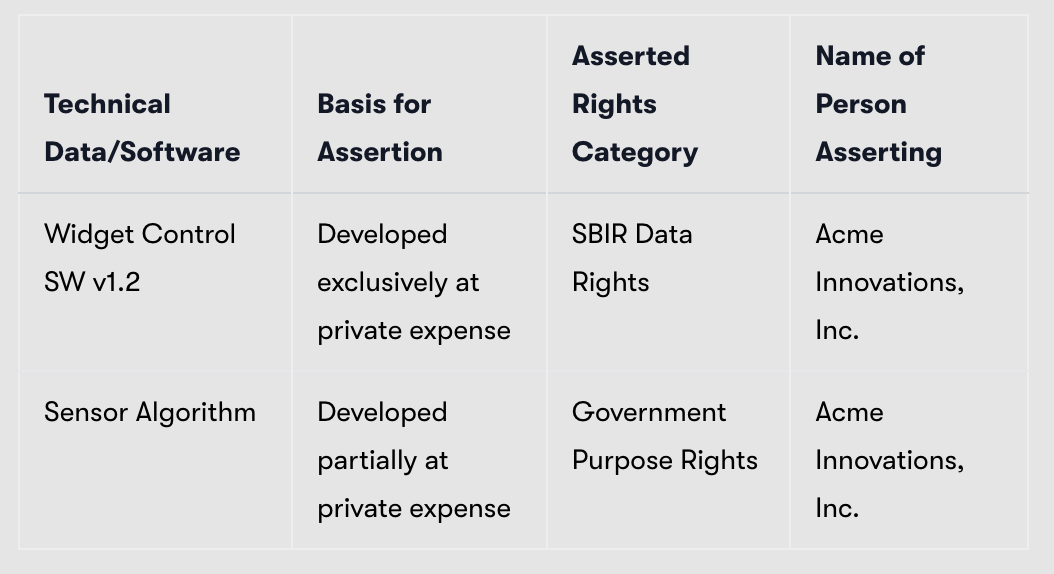How to Fill Out an SBIR Data Rights Assertion Table
If you’re applying for or working under a Small Business Innovation Research (SBIR) contract, you’ll likely be asked to submit a Data Rights Assertion Table. This table is your way of telling the government which data or software you want to protect, and how. Here’s a step-by-step breakdown in plain English.
A little TL;DR: if you are submitting for a Phase I and the final deliverable is a feasibility study or some kind of report, you don’t need to assert rights. Just write “none” and move on.
What Are SBIR Data Rights?
SBIR data rights are special protections for data and software developed under an SBIR contract. This means, you, the small business, can keep control over your technical data and software for a set period, even though the government funded the work. The government can use your data or software internally, but can’t share it publicly or with competitors during the protection period.
When Do SBIR Data Rights Expire?
As of 2025, SBIR data rights last for 20 years from the date of the contract award. After that, the government usually gets “government purpose rights,” meaning they can use and share your data for government purposes only, but not for commercial competition. (source)
What Is the SBIR Data Rights Clause?
The SBIR Data Rights Clause is the legal section in your proposal and contract that spells out these protections and the government’s limitations. It ensures your data is handled according to SBIR rules. If you want to dig into the legalese, check out FAR 52.227-20.
Step-by-Step: Filling Out the SBIR Data Rights Assertion Table
Find Out If You Need the Table
Most agencies require a SBIR Data Rights table even if you aren’t asserting any rights. Check the BAA or Component instructions.
If you’re submitting a proposal or contract deliverable and you want to restrict the government’s use or sharing of any technical data or software, you need this table.
List the Data or Software
Write down the name or description of each item (e.g., “Widget Control Software v1.2” or “Sensor Calibration Algorithm”).
Be specific, don’t just include the software name as that might change over the next 20 years.
State the Basis for Assertion
How was it developed? You have three options to select from:
“Developed exclusively at private expense” (you paid for it)
“Developed partially at private expense” (mixed private and government funding)
“None” (if all data/software was developed with government money and is being delivered without restrictions)
Pick the Rights Category
Choose the right type for each item:
SBIR Data Rights: select this if the for data/software developed completely through SBIR funding.
Limited Rights: select this for data developed a private expense. This is the most restrictive option for technical data. These rights are considered “limited” because the government is still permitted to use, modify, reproduce, release, perform, display, or disclose technical data.
Restricted Rights: select this if the software was developed entirely at private expense. This is the most restrictive option for computer software. Under restricted rights the government can only use the software with one computer at a time, it can’t be licensed across multiple devices.
Government Purpose Rights: select this if the software/data was developed with a mix of private and government funding.
Unlimited Rights: select this for data/software developed entirely with non-SBIR, government funds
Specifically Negotiated License: select this if you’ve agreed on something else with your government customer.
Name the Asserting Party
Put your company’s legal entity name (or the legal name of the individual is asserting the rights).
Sign and Date
If required, add your signature and the date.
What if you aren’t asserting rights: If you’re not restricting anything, write “none” in the table, but make sure you still submit it so contracting knows you completed everything.
Sample SBIR Data Rights Table
Quick Tips
Be specific. Vague descriptions can cause confusion later and screw you over.
Only assert rights for data/software you developed at private or mixed expense, not for things developed entirely with government funds.
Keep copies of your table and supporting documents.
In summary: The SBIR Data Rights Assertion Table is your ticket to protecting your innovation. Fill it out carefully, and you’ll help ensure your company’s IP stays secure while you work with the government. For most SBIR/STTRs in Phase II and beyond, you will be assert “SBIR Data Rights” if you developed some of the initial technology on your own and then adapted it for the government.
SBIR Data Rights FAQ
-
An SBIR Data Rights Assertion Table is a required document in many SBIR proposals and contracts. It lists the technical data and software you want to protect, explains how each was developed, and outlines the rights you’re asserting for each item.
-
If your Phase I deliverable is just a feasibility report or study, you usually don’t need to assert data rights—just write “none” in the table. However, you should still submit the table as required by the agency.
-
As of 2025, SBIR data rights last for 20 years from the contract award date. After that, the government typically receives “government purpose rights.”
-
SBIR Data Rights: Protects your data/software for 20 years; the government can use it internally but not share it publicly.
Limited Rights: Applies to technical data developed at private expense; the government can use but not disclose it.
Restricted Rights: Applies to software developed at private expense; government use is highly limited.
Government Purpose Rights: Allows the government to use and share the data for government purposes only.
-
The SBIR Data Rights Clause is typically found in your contract and proposal documents. For the official language, refer to FAR 52.227-20.
